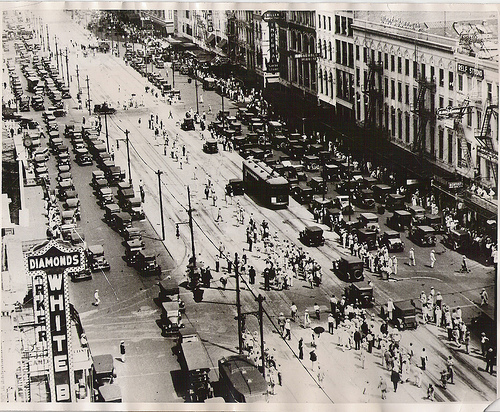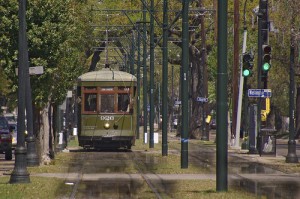communities
Not All Puppies And Babies In New Orleans

Yes, I'm madly in love with New Orleans. That much has been made clear. But I want to make it crystal that in my digging in the nooks and crannies of NOLA, I am well aware that much is broken here. There are a lot of programs and initiatives that start with the best of intentions but don't get off the ground, or don't get enough funding or local support. I wanted to share some of the biggest challenges and frustrations I've seen so far. Because there are so many things broken with New Orleans, I'm going to have to break this into pieces. Today, I'm going to cover infrastructure and transportation.
Cars New Orleans is more of a car-dependent city that I ever would have guessed. It's depressing. Because the public transportation and alternative transportation options and infrastructure are so poor (see below), most people drive everywhere. I have met a few people without cars and they "get by" but it's not a perfect system. Zipcar doesn't operate in New Orleans and I haven't found another option for car-sharing. People proudly say that you can drive anywhere in New Orleans in 15 minutes or less, but just because you can doesn't mean you should.
The streets and sidewalks are a mess. It's hard to find roads without holes or ditches in them and sidewalks are uneven, in disrepair and unmaintained. There are a lot of signs indicating the City is "Rebuilding" but it's hard to pick out a spot where I've been and could remark that the quality of the road was in good condition. This affects all modes of transportation. Drivers are constantly swerving to avoid potholes. Lane separators are a joke. They are faded or nonexistent and most streets that are two lanes are only two lanes in theory and more than likely 1-3 at any given time. It can be like driving in a developing country.
Street signs are of particular disrepair. Maybe one of three times I see a street sign I'm looking for. The rest of the time they are gone, fallen to the ground or hidden by tree overgrowth. It's hysterical and frustrating at the same time. How can a city really make it THIS difficult for a visitor to make their way around? Freeways are just as bad as city streets. Exit numbers and names I get from say, Google Maps, don't match what I see in practice. The city needs to invest in street signs, the big attractive ones you can see from blocks away.
 Bikes
For bikers, the riding conditions are atrocious. All of the gravel and uneven pavement makes riding a bike uncomfortable and dangerous. Riding for "fun" is not a ride around the city. On the levee you can ride for recreational, but it's hard within the city to find roads to cruise on and not have to worry about falling in a ditch. I've riden my bike around a few days and there is no car-to-bike etiquette here. I've been honked at and almost hit twice for no reason other than the cars don't respect bikers. There aren't any biker specific lanes that I've seen, except for a part of Robert E. Lee Blvd and Lakeshore Blvd, which are both out by Lake Pontchatrain and not really for commuters. City Park has a bike track, but again for recreation. Since the city is so small, it seems like such a logical step to look at alternative transportation options like providing better services and infrastructure for bikers. Bogota, Montreal and Amsterdam are three cities with huge bike cultures and in part because of the services offered to bikers that make it more attractive than driving. Using less gas is better for the environment and for people's pockets.
Bikes
For bikers, the riding conditions are atrocious. All of the gravel and uneven pavement makes riding a bike uncomfortable and dangerous. Riding for "fun" is not a ride around the city. On the levee you can ride for recreational, but it's hard within the city to find roads to cruise on and not have to worry about falling in a ditch. I've riden my bike around a few days and there is no car-to-bike etiquette here. I've been honked at and almost hit twice for no reason other than the cars don't respect bikers. There aren't any biker specific lanes that I've seen, except for a part of Robert E. Lee Blvd and Lakeshore Blvd, which are both out by Lake Pontchatrain and not really for commuters. City Park has a bike track, but again for recreation. Since the city is so small, it seems like such a logical step to look at alternative transportation options like providing better services and infrastructure for bikers. Bogota, Montreal and Amsterdam are three cities with huge bike cultures and in part because of the services offered to bikers that make it more attractive than driving. Using less gas is better for the environment and for people's pockets.
Outside of the Tulane and Loyola campus, there aren't any amenities for bikers like city-issued places to lock your bike. What a simple thing. Put places to lock your bike and then bikers don't have to struggle to find a safe place to lock their bikes and the sidewalks aren't cluttered with bikes locked to any available sign. Providing services for bikers increases biking - both participation and acceptance.
 Public Transportation
For public transportation, the streetcar is a great gift to the city, but not reliable. More often than not, three streetcars will be back to back of each other and another doesn't come for 30 minutes. The route is limited. It goes up Canal Street to City Park and the other line runs up St. Charles. It's more than simple novelty for tourists, but two lines can't provide adequate coverage for the inhabitants of New Orleans on a consistent basis. There are some buses, but routes aren't posted on the signs and it just doesn't seem to be what people here use to get from point A to point B.
Public Transportation
For public transportation, the streetcar is a great gift to the city, but not reliable. More often than not, three streetcars will be back to back of each other and another doesn't come for 30 minutes. The route is limited. It goes up Canal Street to City Park and the other line runs up St. Charles. It's more than simple novelty for tourists, but two lines can't provide adequate coverage for the inhabitants of New Orleans on a consistent basis. There are some buses, but routes aren't posted on the signs and it just doesn't seem to be what people here use to get from point A to point B.
Walking There are not any pedestrian blinking walk vs. stop indicators on street corners. I don't know the technical word for them, but you know the blinking flashing light that tells you when the light is green it's ok to walk? They don't have those here. So when you walk across the street, if cars are turning, they don't have to stop for you and quite often act like they're trying to clip you on purpose. It's ludicrous. It's the simplest feature of encouraging people to walk. I hardly see anyone out walking kids in strollers or people in wheelchairs and I don't blame them! Sidewalks, as mentioned, are a mess and the corners hardly ever are handicap-accessible. You'd have to have the mountain climbing version of a stroller or wheelchair to navigate many of New Orleans sidewalks.
Quality of life is the cornerstone for the success of a city. Can people get to where they want to go in an easy and cost-effective way? It starts there. And if more people are using alternative transportation than more people are out in their neighborhoods walking around and getting to know their neighbors. This fosters community. A strong community has a better shot at fighting crime. And crime is a HUGE factor in New Orleans. That's a whole other blog post in itself.
Of course there is more. Environment, housing, job creation, racism, entitlement. The corrupt political system here is a thick cloud that just doesn't go away. People use the failure of their politicians as both an explanation and a crutch. There is a lot to cover. I had to start somewhere.
My advice to the City in New Orleans is invest in infrastructure and transportation first. Do you agree? If not those two topics, where should they start?
If you'd like to learn more about alternative transportation, I suggest checking out the Institute for Transportation and Development Policy. Their newsletter is also quite good.
